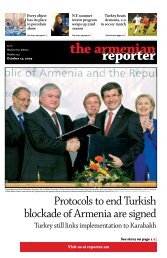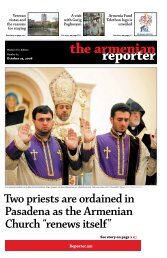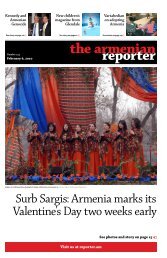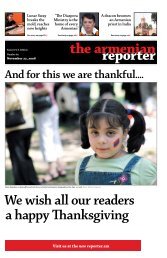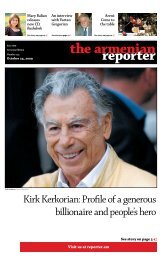The prince charming of Armenian pop - Armenian Reporter
The prince charming of Armenian pop - Armenian Reporter
The prince charming of Armenian pop - Armenian Reporter
You also want an ePaper? Increase the reach of your titles
YUMPU automatically turns print PDFs into web optimized ePapers that Google loves.
Elyssa Karanian.“Our parents were the first hippies in Armenia.”A legacy <strong>of</strong> rockrock<strong>The</strong> boys <strong>of</strong> Bambircarry their musicforward with newvisionsby Elyssa KaranianYEREVAN – It’s hard to write astory about a band whose memberspossess such a cult <strong>of</strong> personalitythat no single angle seems todo them justice. <strong>The</strong>y are young,idealistic, unbelievably talentedmusicians from Gyumri who grewup and into the art world on thewings <strong>of</strong> their parents. <strong>The</strong>y arerepresentatives <strong>of</strong> the Caucasus,bridging the East and West with<strong>Armenian</strong> <strong>Reporter</strong> Arts & CultureCopyright © 2007 by <strong>Armenian</strong> <strong>Reporter</strong> llcAll Rights ReservedContact arts@reporter.am with announcementsTo advertise, write business@reporter.am or call 1-201-226-1995music, lyrics, and style. <strong>The</strong>y carryon a thirty-year musical legacywith creativity and pride. <strong>The</strong>yare progressive, unique, addictingpresences in their own right.<strong>The</strong> boys<strong>The</strong> lead singer and songwriter <strong>of</strong>Bambir is Nareg Barseghyan – ananimated, wild-haired actor whooozes verve and intensity. Hisvoice is emotive and erratic, and asthe songs build, his passion seemsto escape from him in the form<strong>of</strong> verses yelled or whispered orlaughed out. When he glides intohis technically perfect guitar solos,he is like a sketch <strong>of</strong> a person thathas suddenly come together onstage in a full-color image <strong>of</strong> himselfand his music and ideas. Hemasters the crowd.flutist Arik Grigoryan brings awiry, feisty energy to the group.His flute and shvi melodies attimes evoke the smooth, traditional<strong>Armenian</strong> sound, at timesthe manic abandon <strong>of</strong> JethroTull’s Ian Anderson, who is amonghis biggest influences as a musician.With him always front andcenter, it is easy to be drawn towatching his incalculable movements– arms flailing, holleringand howling, percussing on tambourines,maracas, or his cheek.In some ways Arman Kocharyanis an archetypal bass player – subduedand focused – but he is astriking and rare stage presenceOn page C1: Hayko, known for his serenity, has captured the hearts<strong>of</strong> fans through his good looks, romantic ballads, and unique sense<strong>of</strong> style. From his number-one-selling albums to Eurovision, Haykocontinues to be at the top <strong>of</strong> his game. See page C7.C2 <strong>Armenian</strong> <strong>Reporter</strong> Arts & Culture 11/10/2007
Far left: Nareg,Arman, and Arikin Shushi. Photo:Anush Babajanyan.Left above:Dressed up inhonor <strong>of</strong> JohnLennon’s birthday,the boys put on anamazing tributeshow <strong>of</strong> Beatles’covers. Left below:Playing in Gyumri,alongside originalBambir members,the band and itsmusic takes on adifferent feel.who commands attention. Hiseyes, entreating despite his broodingappearance, are never flighty.His fingers move over the stringsbeautifully and it is mesmerizingto watch as he feels the music andplays with a concentration so effortlessthat you want to jump intohis bass and become a part <strong>of</strong> it.Coming from musical, theatricalbackgrounds, the boys are armoredin natural and developedtalent that make them a joy towatch and listen to, on and <strong>of</strong>fthe stage. Nareg grins coyly andtells me that they started to playin 1983. “I say it like that becausethat’s the year we were born, meand Arman,” he laughs. “We grewup on that Bambir style, youknow?”Revolutionary origins<strong>The</strong> name Bambir is derived froma bow-stringed musical instrument(also called a qemani) thatis played much like a cello. ButNareg wasn’t referring to growingup on the style <strong>of</strong> this ancientfour-stringed instrument, nor washe talking about growing up onthe style <strong>of</strong> his own band. Bambiris more than an instrument andmore than a band – it is a musicalhistory, a legend <strong>of</strong> <strong>Armenian</strong> musicand revolutionary thought andaction. It’s a philosophy, a legacy,a culture all its own. It is rock inits element.In 1969, Angin Karer (PreciousStones), the first <strong>Armenian</strong> rockgroup <strong>of</strong> its kind, or perhaps atall, was formed in Gyumri, Armenia’ssecond-largest city, thenknown as Leninakan. Gagik “Jag”Barseghyan (nicknamed for hislove <strong>of</strong> the Rolling Stones) andRobert Kocharyan, fathers <strong>of</strong>Nareg and Arman, explored andexperimented with the arts, creatingmusic and performing intheatrical rock plays such as “Love,Jazz, Devil” (1976). “<strong>The</strong> combinationreally started somethingin the art world,” Nareg says, excitedly.“When they first startedto rehearse everyone was sayingno one would come to the showsor listen to the music because itwasn’t close to the Soviet peopleand problems <strong>of</strong> the time, butthen they did like four shows inone day. It was revolutionary.”Running with the momentumbuilt from their endeavors in thetheater, and after winning anaward at the International MusicFestival in Yerevan (1977), theyformed the group Bambir in 1978.Blending traditional <strong>Armenian</strong>compositions, Celtic and medievalsacred sounds, and Western rockinfluences such as Jethro Tull andthe Beatles, this innovative bandsoon made a name for itself as one<strong>of</strong> the best folk-rock bands in theSoviet Union.In 1978, when this first generation<strong>of</strong> Bambir started playing,they brought Western cultureto Armenia in a musical capacity.“<strong>The</strong>y were playing regularconcerts in Gyumri at that time– covers,” Nareg reminisces. “Hearingthe Beatles from the stage, itwas just a phenomenal thing.”Perhaps too phenomenal for its<strong>Armenian</strong> <strong>Reporter</strong> Arts & Culture 11/10/2007C3
Above left: Armanand Arik sharea mike duringthe first set <strong>of</strong>Bambir’s showat Stop Club inYerevan. Aboveright: Armanembodies JohnLennon for thenight, singing andacting the partwith energeticreverence.Right: Club 12 inYerevan. Dr. Naregtakes a break fromhis stage theatrics.Photo: AnushBabajanyan.time during the band’s early stagesin a Soviet republic. “It was verypagan rock, not nationalistic. Itwas different,” Nareg says. But asthey began to play more <strong>of</strong> theirown compositions – drawing onother, perhaps culturally morepersonal, musical influences suchas Komitas – a loyal fan base developed,not only in Armenia but,in time, internationally as well,throughout other Soviet republics.Bambir won the Folk MusicAward at the International Festivalin Lida, Belarus, in 1982. <strong>The</strong>ycontinued their involvement inthe theater, with stage plays androck operas such as “Jungle BookMaughly” (1986), and continuedto tour and present their musicto international crowds in Russia,Georgia, Baltic countries, and theUnited States.<strong>The</strong> sound that Bambir had createdwas unique and Jag’s lyrics– his keen perception and cleverlyapt expression <strong>of</strong> his ideas –proved the capacity <strong>of</strong> the band tobe a truly monumental presencein the music world.“We are the sons <strong>of</strong> a newgeneration...”At only 24 years old, Nareg, Arman,and Arik are talented beyond theiryears; they are so natural whenthey play, it’s hard to imagine atime when they weren’t this way.Nareg remembers it, though, andsmiles as he talks about what wasperhaps the true beginning <strong>of</strong> thisnew generation <strong>of</strong> Bambir: a fatefulday 1992 when the older Bambirwas on a tour in the UnitedStates. Back in Gyumri, instrumentsin hand, Nareg and Armandecided to put together a surpriseperformance for their fathers’return. Nareg retells the story,laughing: “<strong>The</strong>y came in and la lala we started to play and my fatherlooked at me and said, ‘What shitmusic! Stop playing, I’m tired!’and encouraged me to take up agriculture.”Not to be discouraged, however,the boys (joined, soon after, byArik) continued to play and createmusic, developing a sound thatwould carry Bambir into a new era.Moving forwardToday the boys put on shows thatare frequently surprising as theybuild on themselves and growinto full-blown string-ripping,cymbal-crushing, theatrical rockperformances that are seriouslybrilliant but undeniably funny.<strong>The</strong>re are no straight faces in any<strong>of</strong> their crowds, only the giganticgrins and glossy eyes <strong>of</strong> pure delightas each person connects tothe music, and the boys, in an absolutelystartling way – a phenomenonthat is becoming increasinglyrare in music these days. <strong>The</strong>irsis a pure and raw and honest sort,with no pretense and hardly anyarrogance (given their incredibletalent), just serious music with anedge <strong>of</strong> humor that forever setsthem apart. <strong>The</strong>y have somethingthat’s impossible to ignore.Nareg acknowledges this qualityand attributes it to their roots inthe hardscrabble city <strong>of</strong> Gyumriwhere, despite their tragedies andhardships – including the earthquake<strong>of</strong> 1988 – you may find some<strong>of</strong> the happiest and most generouspeople in Armenia. “Gyumri isa city <strong>of</strong> humor and in many waysthis enters into our music,” Naregsays. “When you play without humornothing can be, nothing cancome <strong>of</strong> it. <strong>The</strong> emptiest artistsare without humor.”C4 <strong>Armenian</strong> <strong>Reporter</strong> Arts & Culture 11/10/2007
<strong>The</strong> humor that Nareg speaks<strong>of</strong>, however, is fantastically balancedby an earnestness thatcomes from having serious ideasand the creative ability and deeplyrooted desire to present themto the public. One <strong>of</strong> the mostimportant aspects <strong>of</strong> the themusic and the band, in Nareg’sopinion, is the fact that they representthe Caucasus. “We shouldrealize that we’re in between,” hesays matter-<strong>of</strong>-factly. “Our faces,our belonging . . . it’s our music.<strong>The</strong>re are thousands <strong>of</strong> other cultures,but, representing the Caucasus,we connect the West andthe East.”<strong>The</strong>y connect the past and thepresent, as well, as they continueto carry the legacy <strong>of</strong> Bambir intothe future and beyond Armeniaand the Caucasus. It’s easy to hearthe influences <strong>of</strong> the past and theirparents on their music but there’sa perpetual forward motion thatpervades their style and their lyrics– an idealism, a philosophy, agoal for this new era. <strong>The</strong>y areundeniably budding rock stars asthey play with the audience andmove through the crowds and explorethe territory <strong>of</strong> being an internationalmusical presence.<strong>The</strong> musicSince they first started playing seriously(Arman says: “It’s a veryserious decision to pick up a guitarand start to play and make aband, so, in that sense, we’ve beenplaying seriously since we were9”), Bambir has written a plethora<strong>of</strong> unique material, recorded andproduced their own albums, andtoured Iran, the Caucasus, Europe,and America. “Our music is alwaysnew for other countries,” Armansays, clearly reviewing thoughtsin his mind as he speaks. “Becausethey drink different water, breathedifferent air, and see differentthings. But regardless <strong>of</strong> what youthink, the music appears, it’s thereto be seen, to be felt. We’re nottrying to make anything beautifulor shiny, or make other people seethings in our music. It’s just comingfrom us. We’re not just playingit, we’re feeling it. So peoplearound the world not only like ourmusic but can see and feel thatthere is something pr<strong>of</strong>ound anddifferent in it, and they can connectto it in their own way.”This connection becomes obviousthe first time one experiencesBambir live. <strong>The</strong> shows explodewith a wayward energy, as the boyscommunicate with the audienceand vice versa, that manifests intoan anomalous essence that drawsfans back continuously. <strong>The</strong> musicspeaks (strongly) for itself but itis simultaneously equivocal, leavingmuch for listeners to actualizeor internalize on their own. Thiscreates a dynamic that can neverbe reproduced, a special bond thatis formed out <strong>of</strong> the interchangebetween stage and floor duringeach show.Discussing the ways in whichBambir is different, Arman takesa thought and runs with it, turningit into a beautiful monologueon music, meaning and the soul<strong>of</strong> the band: “We’re honest withourselves and with our music, andI think that’s the first thing, notonly for musicians, but for anyonewho is trying to say somethingto another person. . . . We’re tryingto be honest with each other,together, within the band, andthat’s how we make music. Wedon’t think about what we’re doinglike, ‘which genre are we in?’or ‘are we playing rock?’ Because,anyway, it’s all about love, nomatter what you’re singing about– art, our music – it’s a way t<strong>of</strong>ind love in all the things that areAbove left:“Without humornothing can be...”Nareg acts out thelyrics to his songs.Above right:Arman interactswith the audience.Photo: AnushBabajanyan.<strong>Armenian</strong> <strong>Reporter</strong> Arts & Culture 11/10/2007C5
fucked up.” He pauses to catch upwith his thoughts, it seems, anddecides, “Yes, we’re different...and that’s where the music starts.That’s where everything starts.”Never singleminded in theirart or their endeavors, the boysare all experimenting with sideprojects in the art world, both ontheir own and for the band. Arik,for example is venturing into theelectronic vibe, mixing tranceand rock. “I want to do some newprojects,” he says before a show atStop Club in Yerevan, where theboys regularly perform. “I’m intothe idea <strong>of</strong> trance-Caucasian rock,”he laughs.But in the end its all about rockand this music that’s been created– this legendary sound and this legacy<strong>of</strong> a name and so much more.“Rock was a faraway thing forthis type <strong>of</strong> nation,” Nareg musesover a cigarette, reflecting on hisfather’s time. He pauses and inhales,“People were looking at it askind <strong>of</strong> an unnormal thing. I don’tknow . . . maybe they still are.” Buttoday, when this new generation<strong>of</strong> Bambir takes the stage, its impossibleto imagine rock in thiscountry without them. fconnect:www.myspace.com/bambirBambir LiveStop Club, Yerevan,Thursday, September 20<strong>The</strong>y open the set with greatenergy. <strong>The</strong> club is tiny and thecrowd is almost on top <strong>of</strong> them,creating an interesting dynamic;everyone is a part <strong>of</strong> this showtogther. Arik goes into a riff onthe shvi and his flutters and trillsring over the bass line and thehigh-hat and even Nareg’s guitaras they jam.Gyumri, Monday,September 24Bambir comes homeI am seeing a completely differentband. Two <strong>of</strong> the original Bambirmembers are on stage, includingJag – Nareg’s father – and thevibe is completely unpretentiousand almost touching. You cansense the connection and the inspirationbetween them all. <strong>The</strong>crowd is completely in love andthe energy is corporeal.Club 12, Yerevan,Wednesday October 3Tonight they’re having fun again.Nareg is dressed up like a doctorand is dancing around like ajointless doll. Arik is like a spriteon stage – wailing and playing airdrums and smiling into the crowd.<strong>The</strong>ir stage theatrics are at a pleasanthigh. Arman plays an entiresong sitting at the back <strong>of</strong> thestage with his head hidden behindthe projection screen. <strong>The</strong> crowdis in love again. At the end <strong>of</strong> theshow they come out and dancewith everyone and for a momentwe all feel a part <strong>of</strong> something pivotalin the music world.Avant Garde Folk MusicClub, Yerevan, TuesdayOctober 9 (JohnLennon’s birthday show)Tonight is a crowd like I’ve neverseen before at any Bambir show.Easily over 150 (but lost countat that), bobbing, throbbing, rollickingfans who are all in blissfulstates <strong>of</strong> drink and dance. <strong>The</strong>band is in its element. Armansings most <strong>of</strong> the songs tonightand it’s like a gem in the set, hisvoice has a melancholy hopefulnessthat’s enchanting. <strong>The</strong>ymove seamlessly and humbly inand out <strong>of</strong> the spotlight with arhythmic modulation that seemsdecades in perfection – and maybeit is, or maybe it’s just theirdeep friendship and love foreach other that gives them thisconnection that pours into andout <strong>of</strong> their music.f<strong>The</strong>re were noempty seats in theGyumri theaterduring the band’shomecomingconcert.C6 <strong>Armenian</strong> <strong>Reporter</strong> Arts & Culture 11/10/2007
Betty Panossian-Ter Sargssian.Hayko has charmed his fans with his good looks, romantic ballads, and sense <strong>of</strong> style.<strong>The</strong> <strong>prince</strong> <strong>charming</strong> <strong>of</strong><strong>Armenian</strong> <strong>pop</strong> is Hayko<strong>pop</strong>by Betty Panossian-TerSarsgssianYEREVAN – One would thinkthat after scoring the Best MaleSinger Award at the <strong>Armenian</strong>National Music Awards in 2006,Hayko had nothing left to prove.After all, this young singer haswitnessed a steady ascent to thehall <strong>of</strong> fame in the <strong>Armenian</strong> <strong>pop</strong>music industry. He has alreadyrecorded four albums, which becameinstant hits and has had animpressive number <strong>of</strong> sold-outsolo concerts in Armenia and thediaspora.But no! This very determinedballadeer then headed to Eurovision2007 in Finland.Hayko spent the past year carefullymapping out the steps heneeded to take for his career.Following a sold-out concertin October 2006 at the VazgenSarkisian Stadium in Yerevan,Hayko released the soundtrack<strong>of</strong> a lengthy film productionMi vakhetsir (Don’t be afraid)directed by Hrach Keshishyan,and produced by the Armenia’sPublic Television. <strong>The</strong> song hechose to sing at Eurovision 2007was from the soundtrack <strong>of</strong> thatmovie.<strong>Armenian</strong> <strong>Reporter</strong> Arts & Culture 11/10/2007C7
On his way up he has charmedfans with his good looks, his romanticballads, and a definitesense <strong>of</strong> style.From classics to <strong>pop</strong>balladsGrowing up a mischievous boywho liked to play in the streetwith his friends, Hayko did nothave any particular dreams <strong>of</strong> becominga singer or a star. “I neverintended to become a singer. Infact I wanted to become a jazzpianist,” he says over ice creamat the Marriott-Armenia café inYerevan. When I asked him hisage, Hayko didn’t disclose it,but said that his birthday ison August 25. “I always tellpeople that I sleep besidethe fridge so that I won’tage,” he joked. Regardless<strong>of</strong> his age, musichas always been apart <strong>of</strong> his life.From his earlyschool yearsHayko startedtaking violin lessons.<strong>The</strong> gradualshaping <strong>of</strong> thefuture musicianwould take a moredecisive turn when he continuedhis high school studies atthe Romanos Melikyan musicschool. <strong>The</strong>n he continuedhis studies at the YerevanState Conservatory, aspiringto become a conductorand a composer in classicalmusic. Young Hayko soonfound himself playing thekeyboard in various <strong>pop</strong>bands in Yerevan. At thesame time he was writingsongs for other singers.Singing happenedspontaneously. “Songsare born with singing,and then it occurredto me why don’t I startsinging some <strong>of</strong> myown songs?” he says.His transition froma wannabe classical musician to abudding young <strong>pop</strong> star happenedwith the release <strong>of</strong> his first videoclip for the ballad Im Ser (My love)in 1996. Meanwhile, he began appearingon stage as a singer at theState <strong>The</strong>ater <strong>of</strong> Song, under thepatronage <strong>of</strong> Arthur Grigoryan,widely known as the patron <strong>of</strong> the<strong>Armenian</strong> <strong>pop</strong> music industry.While waiting to become one <strong>of</strong>the most successful artists in contemporary<strong>Armenian</strong> <strong>pop</strong> music,for some years Hayko enjoyed akind <strong>of</strong> second-tier level <strong>of</strong> fame.Participation in various musicalcontests and awards were accompaniedwith succeeding albums,and an increasing army <strong>of</strong> fans,mostly young females, in both Armeniaand the diaspora.Hayko has a very busyschedule where workwith new recordingsdominates most <strong>of</strong> histime.In 1996, Hayko began to appearon the stage <strong>of</strong> various <strong>Armenian</strong>and international music competitions.That same year he participatedat the Moskva 96 (Moscow1996) music festival and wonfirst place. It was at that festivalthat Hayko Hakobyan portrayedhimself simply as Hayko. “At thecontest we wanted to be rememberedby the name, too. <strong>The</strong>reforeI chose to be known as Hayko, asimple and short name, easily remembered,”says Hayko. In 1997Hayko won first prize at the BigApple Festival in New York. In1998 he was acknowledged as thebest singer-songwriter at the Ayocompetition.His first album was released in1999. It immediately became a hitin Armenia. <strong>The</strong> very romanticalbum, Hayko Romance, includeda dozen <strong>of</strong> the most <strong>pop</strong>ular <strong>Armenian</strong>romantic ballads. “It hasbeen the shortest path to my suc-C8 <strong>Armenian</strong> <strong>Reporter</strong> Arts & Culture 11/10/2007
Hayko withsingers HasmikGarabedyan (l.)and Emmy.cess,” says Hayko. After years <strong>of</strong>being nominated at the <strong>Armenian</strong>Music Awards, in 2003 he releasedhis Best <strong>of</strong> album on DVD, and gavehis first solo concert at the Alex<strong>The</strong>atre in Glendale, Calif.Back home in Yerevan, Haykogave a solo performance in May2003 and recorded his Live ConcertDVD. In the same year he releasedhis first album authored by himself,Norits (Again), and receivedthe Best Male Singer Award at the<strong>Armenian</strong> National Music Awards.A year later, in 2004 Hayko releasedhis fourth album, Mi khoskov(In a word). Once again, hewas recognized as best male singerat the 2006 <strong>Armenian</strong> NationalMusic Awards.Hayko also is a music producerfor many <strong>pop</strong> singers. He composesand arranges music. Hehas written songs for <strong>Armenian</strong><strong>pop</strong> singers Tigran Petrosyan, Sirousho,and Emmy, to mentionthree. He plans to expand his musicproduction as soon as his newstudio is completed. In spite <strong>of</strong> hishandsome looks, Hayko has yet toappear in movies, although it issomething he says he hasn’t activelypursued. “My input in thefilm industry is to compose songsfor <strong>Armenian</strong> movies,” he says.Among his collaborations is thesoundtrack <strong>of</strong> a new soap operaproduced by Armenia TV. “I havecomposed the soundtrack, andwritten songs to be performedby me and other <strong>Armenian</strong> <strong>pop</strong>singers.” He is currently workingon the soundtrack <strong>of</strong> yet anotherfilm, a love story being directed byHrach Keshishyan.Hayko has a very busy schedulewhere work with new recordingsdominates most <strong>of</strong> his time. Thissummer, while much <strong>of</strong> the cityhad escaped from the heat anddust <strong>of</strong> Yerevan Hayko was contributingto the dust, buildinga new studio close to his homein the Avan district <strong>of</strong> Yerevan.Hayko still lives with his family,but as soon as the building <strong>of</strong> thenew studio is constructed, he willmove there to live alone. “Naturallyit is something I always wanted,but I know that I always will bevery close to my family.”Lucky in love in theUnited StatesHayko is known for his serenity.His public appearances, on and <strong>of</strong>fthe stage have always portrayeda cool image. However he is passionatein his “cool,” romantic, andcharismatic way. He is very mucha composed <strong>prince</strong> <strong>charming</strong>, “ButI am not that calm at all. I alwayslike to have movement aroundme. I am always doing something,”says Hayko.In the evenings he likes to spendsome time with his friends. “I love<strong>Armenian</strong> <strong>Reporter</strong> Arts & Culture 11/10/2007C9
Right: Hayko at aconcert in Yerevan.Far right: Haykoat age two.Hayko, uponhis return fromEurovision inFinland. Photo :TV Mol.to go to cafés, restaurants, andclubs. I like good food. I play tenniswith my brother. I am alwaysin action,” he says.A sought-after bachelor, Haykoappears alone in public. “I amvery much unattached romantically,but I strongly desire to findmy love, get married, and settledown. Perhaps it will happen inthe United States. That countrybrings me luck in love, since Ihad fallen in love there and hada girlfriend,” says Hayko. He isdefinitely a heartthrob. He laughsself-consciously when I mentionthis. However, besides hisgood looks, he always maintainsthe pr<strong>of</strong>ile <strong>of</strong> being a well-manneredand respectable man. “I ama common <strong>Armenian</strong> man, whorespects everyone. I was educatedto be like this. I always try hardto do everything that is right andsuitable for an <strong>Armenian</strong> man,”says Hayko.European tours followEurovisionEurovision was clearly the mostambitious project <strong>of</strong> Hayko’scareer. He was already a well establishedname before the contest.But why would a singer withhis status need to participate inEurovision? Hayko admits thatit was a very big risk. “Even myproducers asked me not to go toEurovision, because I already wasa well known singer and did notneed that. <strong>The</strong> responsibility ishuge, because you are representingyour country and it wouldhave been too bad had I not sangwell, or achieved a lower rank.”(He came in eighth.) However,Hayko thought that an opportunitylike that is given only once ina lifetime and wanted to live theexperience.“I was sure <strong>of</strong> myself,” saysHayko. “I had faith in my friendsaccompanying me. My producerArthur Janibekyan together withArmenia’s Public Television dideverything to ensure that it allwent well. My show was stagedby the well-known Alain Sichov. Ithink that we all had a dazzlingperformance because <strong>pop</strong> singersGoga, Tigran Petrosyan, Arthurfrom the Opera and Ballet <strong>The</strong>ater,and Ara Torosyan, a master in musicalarrangements, who are all myvery dear friends were by my side,”says Hayko.“Songs are born withsinging, and then itoccurred to me whydon’t I start singingsome <strong>of</strong> my own songs?”At Eurovision Hayko’s performancewould determine the future<strong>of</strong> his singing career. “I wasvery well prepared. As soon as wewere in Helsinki, it became clearthat we had a good chance to competefor first place, because everyonewas talking about our showand performance.” Eurovisionlaunched a series <strong>of</strong> new concertsin Europe for Hayko. It providedthe young <strong>Armenian</strong> singer withthe heartthrob looks access to abroader audience, a European one.“I am invited for concerts all overEurope,” says Hayko.Hayko’s European tour will culminateby solo concerts in theUnited States at the beginning <strong>of</strong>2008. fC10 <strong>Armenian</strong> <strong>Reporter</strong> Arts & Culture 11/10/2007
<strong>The</strong> Zobian phenomenon(On the occasion <strong>of</strong> the fifth anniversary <strong>of</strong> his passing)by Aroutun PalianoperaI had not written anything for along time until my friend GerardSvazlian, who is currently a violinistin the orchestra <strong>of</strong> the SanFrancisco Opera Company, suggestedthat I write an article aboutthe renowned singer and soloist <strong>of</strong>the Bucharest Opera, Garbis Zobian.Gerard Svazlian had workedwith Zobian in his younger yearswhile he was a member <strong>of</strong> the YerevanNational Opera Orchestra.<strong>The</strong> temptation to write such anarticle was great, since G. Zobianwas paramount among all the wellknowndramatic tenors, as far as Iwas concerned.Inasmuch as I have been steepedin the traditions <strong>of</strong> classical musicand am familiar with the art <strong>of</strong>past and contemporary singers,Enrico Caruso, Gino Bechi, and G.Zobian have special significancefor me. God lavishly endowedthese singers with inimitable voices,which easily leveled the pathin front <strong>of</strong> them, like copiouslygushing rivers that are impossibleto resist. If talents are bornrelatively <strong>of</strong>ten, then phenomenaappear every couple <strong>of</strong> centuries.Suddenly a personality is born,who tops his predecessors whilepossessing their best characteristicsand experience. We call suchan individual a “phenomenon.”Such phenomena were Leonardoda Vinci, Bach, Paganini,Mozart and Caruso. <strong>The</strong> Peruviansinger Yma Sumac was a phenomenon,owing to the extensiverange <strong>of</strong> her voice. Caruso was aphenomenon because, prior tohim, mankind had not heard suchan unusually beautiful and powerfulvoice, which was capable <strong>of</strong>performing operatic arias <strong>of</strong> themost different nature, romances,Italian and Neapolitan songs. Carusoremained unique, althoughthe music business world proceededto present Gigli, Mario delMonaco and Mario Lanza to thepublic as the new Caruso.While the recording instrumentsat the beginning <strong>of</strong> thetwentieth century were primitive,they had become quite perfectedby the 1950’s and reproduced humanvoices more naturally. Bornafter Caruso was a new generation<strong>of</strong> talented singers, which lackeda “peak.” That peak was Garbis Zobian,whom God had graced withan exceptionally beautiful voice,coupled with obvious emotionalism,expressiveness and natural,vivid dramatization. In the case<strong>of</strong> certain well-known singers,dramatization is created throughthe intensity <strong>of</strong> the voice or artificialtension, and with the use <strong>of</strong>a microphone. Zobian’s voice wasGarbis Zobian inPagliacci (Canio).naturally endowed with dramaticcolor, and he didn’t need to exertartificial effort when singing highnotes. In all segments <strong>of</strong> his voicerange, the sound was symmetricaland smooth. Zobian’s voice canonly be compared to and competewith his own. Melik-Pashaev (Melik-Pashayian),principal conductor<strong>of</strong> the Bolshoi Opera <strong>of</strong> Moscow,described Zobian’s voice as“heroic tenor.” Heroic because itfreely gave renditions <strong>of</strong> the mostcomplex and difficult arias <strong>of</strong> operaticmusic: Othello, Canio, AndreaChenier, Radames, Cavaradossi,Hermann, Turidu, Manrico,and others.<strong>The</strong> purpose <strong>of</strong> this article isnot to comment on the singer’sperformances but to explain theZobian phenomenon.Was Zobian’s birth perhaps accidental?I would say no. <strong>The</strong> reasonis that the universe and all thephenomena being carried out in ithave been previously planned out<strong>Armenian</strong> <strong>Reporter</strong> Arts & Culture 11/10/2007C11
Garbis Zobian in Dame de Prague (Ghermann).Above: GarbisZobian (DonJose) and Blanche<strong>The</strong>bom in Carmen(1960).in detail. Contingency is the fruit<strong>of</strong> human ignorance.<strong>The</strong>re are a few factors in thematter at hand. First, there werealready good-quality recordingtools in existence, which couldrecord the natural beauty <strong>of</strong> thehuman voice.Zobian was born one monthafter the <strong>Armenian</strong> Genocide.That unspeakable carnage, to allappearances, was condemned byforemost politicians, intellectualsand artists.God, who had generously endowedthis child, could not accommodateHimself to the loss<strong>of</strong> Garbis; therefore, He savedmother and child from inevitabledeath.It is undeniable that the mother’ssuffering and restless state <strong>of</strong>mind had an effect on the formation<strong>of</strong> the young Zobian’s spiritualworld during the period he wasnursed by her. (So did her subsequentoral histories too.)Garbis Zobian in Othello.Garbis Zobian in Carmen (Don Jose).<strong>The</strong> second factor is that God hadgiven the <strong>Armenian</strong> people such talentedand well-known singers as PietroSacinari, who was <strong>of</strong> <strong>Armenian</strong>background, Armenag Shahmuradianand Arman Tokatian. <strong>The</strong> timehad ripened, and the next peak hadto be born. That was Garbis Zobian.For some, all this may perhaps seemstrange, but, for me, that is in conformitywith universal law. Zobianhad to be born.I’m glad that, in my early youth,I had the opportunity to hear thesinger from the stages <strong>of</strong> the YerevanOpera <strong>The</strong>ater and the largeconcert hall <strong>of</strong> the <strong>Armenian</strong>Philharmonic Orchestra. Subsequently,while working as editor<strong>of</strong> musical programming for theState Committee <strong>of</strong> Radio andTelevision in Yerevan, I becamequite familiar with the performingart <strong>of</strong> not only Zobian but alsoother eminent Diasporan <strong>Armenian</strong>musicians.It is appropriate to note here theconsistent work done by the chiefeditors, Armen Hovhannisian andAndranik Chalgushian, and allthe employees <strong>of</strong> the <strong>Armenian</strong>musical editorial department, inassembling the existing recordings<strong>of</strong> Diasporan <strong>Armenian</strong>s andmaking new ones.<strong>The</strong> writers <strong>of</strong> articles stating thatC12 <strong>Armenian</strong> <strong>Reporter</strong> Arts & Culture 11/10/2007
Zobian acting was so real that itwas uncanny were telling the truth.I can still picture Zobian as Josewith his partner, Sonia Kamernik,a soloist with the S<strong>of</strong>ia Opera whowas <strong>of</strong> <strong>Armenian</strong> extraction. At theend <strong>of</strong> the act, the curtain closedbut it quickly opened to the loudcheers <strong>of</strong> the audience. Carmenwas still in Jose’s arms. <strong>The</strong> singerhad to bring Zobian back to realitywith a deft movement <strong>of</strong> the hand,in order to remind him that the acthad finished.In a performance with the <strong>Armenian</strong>Philharmonic Orchestra,Zobian began with operatic ariasand songs <strong>of</strong> Western Europeancomposers, finishing with theworks <strong>of</strong> <strong>Armenian</strong> composers,demonstrating the capabilitiesand flexibility <strong>of</strong> his voice. His renditions<strong>of</strong> Komitas’s “Kele-Kele”and “Hayastan” were quite impressive.<strong>The</strong> first is a tender lovescene, while the second is a majesticpiece expressing the hopes <strong>of</strong>the <strong>Armenian</strong> people, a source <strong>of</strong>inspiration and the embodiment<strong>of</strong> patriotism. Notwithstandingthe singer’s dramatic voice, lyricismwas present in the first song,grandeur in the second. It was asif the singer was saying that hewas proud to be <strong>Armenian</strong>.Just as Niagara Falls spreadsout and tumbles down, displayingits beauty and might, so too doesthe “panorama” <strong>of</strong> the Zobianphenomenon open up before thelistener.Although opera lovers and distinguishedmusicians <strong>of</strong> EasternEurope and the Soviet Union werefamiliar with Zobian’s art, he wasdestined for the world’s mostprominent stages. What preventedhim from achieving internationalrenown? <strong>The</strong> jealousy <strong>of</strong>mediocrities toward great figures.<strong>The</strong> Metropolitan’s impresario hadsuggested to Zobian to accept hisinvitation to sing at the New YorkMetropolitan Opera. <strong>The</strong> worldfamousconductor Herbert vonKarajan, upon hearing recordings<strong>of</strong> Zobian made by the Czech companySupraphon, invited him for atryout in Vienna. However, sinceGarbis Zobian was not a member<strong>of</strong> the Communist Party, unfortunatelyhe was not allowed to honorany invitation from the West. <strong>The</strong>critics <strong>of</strong> the British Opera andGramophone monthlies spoke withthe highest praise about Zobian,comparing him to Caruso. Afterall this, isn’t it a crime to bury theZobian phenomenon in oblivion?If talents are born relatively <strong>of</strong>ten,then phenomena appear everycouple <strong>of</strong> centuries.Zobian departed from this worldfive years ago, leaving us unforgettablememories. Today, the solewitness to his art are the recordings<strong>of</strong> operatic arias and Italiancanzonets sung by him and producedby the Czech record companySupraphon, as well as those<strong>of</strong> a few Romanian and <strong>Armenian</strong>songs kept in the catalogues <strong>of</strong>Radio Yerevan.<strong>The</strong> Zobian phenomenon was aslap in the face to those who carriedout the <strong>Armenian</strong> Genocideand, generally speaking, despoticregimes.<strong>The</strong> only means <strong>of</strong> preservingthe memory <strong>of</strong> the Zobian phenomenon<strong>of</strong> the second half <strong>of</strong> thetwentieth century is releasing a CD<strong>of</strong> his recordings. Just as the worldknows the Italians through Caruso,Verdi and Paganini, so too must wemake our presence known throughthe likes <strong>of</strong> Zobian, Gohar Gasparian,Jean Ter-Mergerian, ParuyrSevak, Minas Avetisian and AramKhachaturian. <strong>The</strong>se are the greatfigures, whose statues or bustsmust be placed in concert halls,opera theaters and public squares,so that future generations and foreignvisitors may know us.I appeal to all political parties,public and cultural organizations<strong>of</strong> the Diaspora and Armenia alike,as well as individual music loversand persons, in whose veins flowsthe pure <strong>Armenian</strong> blood <strong>of</strong> HaikNahapet, Ara Geghetsik, GevorkMarzpetuni and Davit-Bek, to dowhatever possible to make availableto the public CDs <strong>of</strong> the recordings<strong>of</strong> not only Garbis Zobian butalso the aforementioned artists. Itis my hope that the current employees<strong>of</strong> Radio Yerevan too willnot refuse to <strong>of</strong>fer their assistanceby continuing the worthy traditionestablished years ago. It is time totranslate words into deeds. This isan activity and a policy <strong>of</strong> benefitto the <strong>Armenian</strong> people.<strong>The</strong> author is a former supervisor<strong>of</strong> musical programming forthe State Committee <strong>of</strong> Radio andTelevision in Yerevan. ftranslated by Aris G. SevagFar left: GarbisZobian (DonJose) and Blanche<strong>The</strong>bom in Carmen.Left: GarbisZobian in Pagliacci(Canio).<strong>Armenian</strong> <strong>Reporter</strong> Arts & Culture 11/10/2007C13
My myrigKay Mouradianstoryby Kay MouradianMy myrig and I had an endearingrelationship. She never interferedwith my life, never held me backfrom exploring or living in manyparts <strong>of</strong> this glorious planet. AndI always returned home. My myriglived by a philosophy that you holdby letting go. Pretty remarkablefor this small 5-foot woman whosurvived the <strong>Armenian</strong> Genocide,whose life had been colored bythe horrors <strong>of</strong> the past, and whodwelled on the loss <strong>of</strong> her familymembers who had perished at thehands <strong>of</strong> the Turks. <strong>The</strong>n one daythat dark shadow was gone and hertransformation is quite a story.In 1988 I had gone to Aleppo,Syria, to search for the family thathad given my myrig refuge fromthe Turks. Incredibly, I found theone remaining descendant. Bornafter my mother had left Aleppo,the handsome woman knew allabout the 14-year-old <strong>Armenian</strong>girl, Flora, who had cared for hertwo sisters. Delighted to meet me,she gave me a gift I still cherishtoday – photos <strong>of</strong> her sisters, hermother and <strong>of</strong> her father, a kindman who treated my mother asone <strong>of</strong> his own.<strong>The</strong> day after our extraordinarymeeting, I received a call fromhome. Myrig was back in the hospital.I left for Los Angeles.Myrig had already had threeprevious trips to death’s doorand to the amazement <strong>of</strong> all, includingher doctor, she managedto survive those precarious episodes.But this time, when I sawmy mother on that hospital bed, Iwas sure her time had come. Shewas deathly frail.When she saw me she tried tosmile, but was far too weak. “Idon’t know why I didn’t die,” shesaid, her voice barely audible.Kay Mouradian’s mother, who said,“Hunger is a pain that never sleeps.”I, too, wondered. I would haveexpected her to embrace the release<strong>of</strong> her worn-down body, especiallyafter having been so closethree times in the previous fouryears. Or did she know somethingI didn’t? I leaned in close and said,“Mom, do you think you will dienow?“It doesn’t look like it,” she said,her voice cracking and her face reflectingher own disbelief.Somehow she knew.Two days later, when I enteredthe cardiac care unit I was surprisedto see Myrig sitting up inbed, unattended. <strong>The</strong> day before,she couldn’t turn her head withouthelp. But when she saw meapproaching she shouted somethingin Turkish, a language shehadn’t spoken in more than fiftyyears.I was startled. She was filledwith energy. And why was shespeaking Turkish, the language<strong>of</strong> those she hated? “Mom, I don’tunderstand you,” I said, trying tocalm her. “Speak to me in Englishor <strong>Armenian</strong>.”She kept shouting in Turkish,and I began to panic. What if shecontinued to speak only Turkish?Would I lose contact with her forever?Could I retrain her brain tothink in English?“Mom,” I said firmly, “repeateverything I say.” I went throughthe entire English alphabet. Sherepeated each letter dutifully, asif she were in school following ateacher’s instructions. We countednumbers and she repeated those inEnglish. But she started to shoutin Turkish again with an Englishor <strong>Armenian</strong> word in the mix. Istruggled to understand. <strong>The</strong> bestI could comprehend was:“<strong>The</strong>y took my education,” sheyelled.“<strong>The</strong>y took my family!“Do you know what it was like?“I went crazy!”She looked straight into my eyes,said loud, and clear in English.“<strong>The</strong> bastards!”Even though there were momentswhen I felt panic, othermoments like this one were justplain comical. I couldn’t hold backa laugh. I had never before heardher use this crude word. Andthroughout this wild scenario,even though she was shouting inTurkish, she appeared to be joyful.“Mom, are you happy?” I askedtrying to understand this phenomenon.“Yes,” came her emphatic reply.“Why?”“Because I’m awake!” she saidwith authority.I found her choice <strong>of</strong> word intriguing.I would have expectedher to say, “Because I’m alive.” ButI had a suspicion <strong>of</strong> what mighthave happened.With my keen interest and years<strong>of</strong> study in eastern philosophy, Iwondered if she had crossed overinto another plane and witnessedthe <strong>Armenian</strong> Genocide from ahigher, impersonal view. Hadshe gained an understanding <strong>of</strong>the horrific karmic debt the perpetratorshave to pay? And hadC14 <strong>Armenian</strong> <strong>Reporter</strong> Arts & Culture 11/10/2007
she been given an opportunityto release her own intense hatred<strong>of</strong> the Turk? Was that hatred releasedwith the strong expulsion<strong>of</strong> her anger as she shouted, “thebastards,” a word not in my oldfashionedmother’s vocabulary?I’ll never know for sure, but I canstate for a fact that my myrig wasso loving after this fourth brushwith death that she couldn’t harborhatred, not even toward theTurks. Love poured out <strong>of</strong> herheart, like a flower releasing itsperfume. Everyone around herfelt it.But this was not the only bizarreincident during my mother’slong illness. Her second bout withcongestive heart failure in 1986was also a stunner. With her heartlaboring in cardiac care, her doctordidn’t expect her to survivethe night. Three <strong>of</strong> us sat at herbedside, waiting. Myrig had beenunresponsive. <strong>The</strong>n she started tospeak.“Do you know why I’m still here?”she asked, sounding as if sheknew a great truth. She lookedat my cousin and said, “becauseyou don’t have any children.” Sheturned toward me and again said,“because you don’t have any children.”<strong>The</strong>n to my nephew sittingnearby she said, “And you don’thave any children. If I died no onewould know.”“<strong>The</strong>y showed me a lot <strong>of</strong> pictures,”she continued.I wondered who the “they” were.I knew people with near-deathexperiences claimed to view theirlives at the moment <strong>of</strong> death. Wasmy mother sharing the same kind<strong>of</strong> vision with whoever the “they”were?She looked at my cousin andsaid, “Your mother was there.” Hismother had died thirty years earlier.She mentioned seeing an <strong>Armenian</strong>family who was a karmicmirror <strong>of</strong> her family and told usprophetic things that would happento members <strong>of</strong> our own family.Two <strong>of</strong> them have already cometo pass.<strong>Armenian</strong> <strong>Reporter</strong> Arts & Culture 11/10/2007“<strong>The</strong>y showed the afghans,” shesaid. She had made afghans overthe years for everyone: relatives,neighbors, my friends, her friends,and my sister’s friends. Interestingly,after this vision she madethem specifically for disabled veterans.She turned her gaze to me.“You’re going to write a book aboutmy life.”“No, mom, not me,” I said. “Maybeyour other daughter will. She’sthe real <strong>Armenian</strong> in the family.”“No! You are! And you’re going tobe on the Donahue show!”<strong>The</strong> Donahue Show! In 1986 Donahuewas the king <strong>of</strong> talk shows,and she never, but never, watchedthat program, and I immediatelydismissed that statement as delusion.<strong>The</strong>n she ended her little speechwith, “<strong>The</strong>y said it was my choice.”Now, that sentence gripped myattention. I’ve spent my adult lifetrying to make right choices, and itis not ever an easy thing and nowmy mother had made the choiceto stay on in defiance <strong>of</strong> her body’sfragile and deathly state. She hadmore to do before she could let go.I just didn’t know it at the time.Against the odds she rallied anda few days later was released fromthe hospital. In the middle <strong>of</strong> herfirst night home I heard her stir.I rushed into her bedroom andturned on the light. <strong>The</strong>re she satin bed, her face absolutely radiant.She gave me a huge smile. “Do youknow what life is all about?” sheasked, not waiting for a reply. “It’sall about love and understanding,but everyone’s brain is not the same,so you help when you can. That’swhat life’s all about.” She smiled,laid herself down and went backto sleep. I will never forget thatnight.<strong>The</strong> next day she again couldn’tmove without help.I had dismissed much <strong>of</strong> her visionon that hospital bed as delusion.I certainly had no plans towrite a book about her or the <strong>Armenian</strong>tragedy. My mind was focusedon researching materials forexercises that stimulate the body’s“chi,” and I had been accepted tostudy at the Acupuncture InternationalTraining Center in Beijing,But what was happening to mymyrig was remarkable. I began toread about events that happened inthe Ottoman Empire during WorldWar I and became overwhelmed. Ihad not known the depth <strong>of</strong> the<strong>Armenian</strong> tragedy, and I began tounderstand my mother’s heartbreakingscars and those <strong>of</strong> <strong>Armenian</strong>survivors everywhere. Now Iknew my mother’s story needed tobe told, the whole <strong>of</strong> it, includingthe blessing that was granted herin her last years.I set aside my plans to study inChina to write my mother’s storyas a fictionalized memoir. Not realizingthe depth <strong>of</strong> the necessaryresearch, the nuances <strong>of</strong> writingfiction, or how many years it wouldtake, I had to write about this littlewoman who kept escaping deathand instead became more alertand more loving each time. Mymyrig taught me that when negativematrices like hatred and angerno longer rule the heart, streams<strong>of</strong> fragrant love pour out <strong>of</strong> everycell in the body. She shined like athousand suns.fKay Mouradian’s fictionalized memoir <strong>of</strong>her mother is called A Gift in the Sunlight:An <strong>Armenian</strong> Story and can be orderedfrom www.garodbooks.comKay Mouradian’smother crochetingan afghan.C15
Naush Boghossian.Le Mur de LaPropriete, 1957,oil on canvas50 x 60cm.Carzou represents acentury through his artcanvasFrench-<strong>Armenian</strong>artist’s unrivaled styleby Naush BoghossianGLENDALE, Calif. —<strong>The</strong> art communityis celebrating the work <strong>of</strong><strong>pop</strong>ular French-<strong>Armenian</strong> artistJean Carzou, on the year he wouldhave turned 100.Seven years after his death atthe age <strong>of</strong> 93, Carzou’s paintings,drawings and watercolors will beon display through the end <strong>of</strong> themonth at Stephanie’s Art Galleryin La Canada, Calif. – work itsartistic director says reflects theconscience <strong>of</strong> the 20th century.Carzou’s art, which graces museumsin France, Russia, Australia,Israel, and Egypt among othercountries, remains as relevant asever in a world that continues tograpple with war, ethnic strife,and the ever-increasing influence<strong>of</strong> technology.But the continued appreciation<strong>of</strong> his work is perhaps the greatesttestament to a man who neverdeserted his faith in humanityand nature; his art embracing thehope that light and peace are presenteven in the darkest creations.“Springing from somewhere,life will always bud again,” as describedby Grigor K’eoseyan in hisbook Carzou: Mogakan ashkhari menkarich’e (translated into Englishby Ara Kalaydjian).Born Karnig Zouloumian onJan. 14, 1907, in Aleppo, Syria,Carzou grew up in a volatile andrevolutionary time. He saw twoworld wars, economic depression,the Cold War with its threat <strong>of</strong> nuclearannihilation, and the rapidadvancement <strong>of</strong> technology.Although he escaped the 1915<strong>Armenian</strong> Genocide, the eventbecame the source <strong>of</strong> a recurringtheme in his work: desolation andsolitude. And though he was notagainst progress, he was also consumedby the increasing influence<strong>of</strong> technology on modern life.Carzou said <strong>of</strong> progress, “<strong>The</strong>machine cannot change humandestiny; and I believe firmly thatby distancing himself from nature,man actually departs fromtruth. . . . I see a great many captives,but very few happy people.”Carzou’s first significant brushwith art came at the age <strong>of</strong> nineafter the death <strong>of</strong> his father, whenhe and his mother took over hisfather’s photography business.He later studied architectureC16 <strong>Armenian</strong> <strong>Reporter</strong> Arts & Culture 11/10/2007
in France, but he was constantlypulled to drawing. He won manyprizes and during financially difficulttimes, he supported himselfwith his passion by drawing caricaturesand political cartoons forlocal newspapers and magazines.He started to make his mark onthe art world in his early 20s andby the 1940s he was well known inthe field.According to K’eoseyan, Carzoudidn’t belong to any school <strong>of</strong> art,dabbling in a range <strong>of</strong> movementsfrom naturalism to cubism, surrealismto imagery and back to thenaturalist art movement.“When we study Carzou’s workin its entirety, we observe that itsevolution – with all the inherenttransmutations – forms a circularcourse, and that the artist <strong>of</strong>tenreturns to his original point <strong>of</strong> departure,enriched by maturity, experienceand crystalline pr<strong>of</strong>oundnessattained during the decades,”K’eoseyan wrote.But Carzou was most comfortablein naturalism, stemming fromhis belief that nature transcendsman, and that its ability to live onand regenerate is a testament toits pr<strong>of</strong>ound truth.Most <strong>of</strong> his work is markedby the presence <strong>of</strong> women. ForCarzou women represented peaceand the rebirth <strong>of</strong> mankind, incontrast to the wars and machinescreated by man.“She is everywhere, in every period,the commanding figure, indivisiblefrom Carzou’s universe andits distinctive characteristics. <strong>The</strong>Carzou woman . . . More accuratelya goddess,” K’eoseyan explained.Though Carzou was primarily apainter, his art is not limited toworking on canvas. He worked ontextured, unusual surfaces includingporcelain, tapestries, and ceramics.His body <strong>of</strong> work includes departuresfrom traditional paintingsto illustrating books bywriters including Albert Camus,Shakespeare, Rimbaud, and ErnestHemingway and even helpingdecorate the ocean liner “<strong>The</strong>France.”Carzou gained instant fame in1952 for his set designs and costumesfor the Comedie Francaiseand the top ballet and opera houses<strong>of</strong> Paris, including the ParisOpera, and the Harkness DanceCompany <strong>of</strong> New York.Though he did quite a few stagedesigns, Carzou admitted thatthey took too much time from hisother creative endeavors, so hedecided to return to his paintings.At the age <strong>of</strong> 81, Carzou completedpainting the walls <strong>of</strong> achapel in the south <strong>of</strong> France. Hepainted the Apocalypse <strong>of</strong> SaintJoan in the Chapel at Monosquein Vaucluse, France. This chapelbecame a tribute to the artistwhen in 1995 it was dedicated asthe Museum de Jean Carzou.He even left an indelible markin the artistic world when in thelate 1930s his work took on color.He created a distinct shade <strong>of</strong> emeraldblue and later in his careera distinct shade <strong>of</strong> deep, flamingred, known today as “Carzou Blue”and “Carzou Red” respectively.<strong>The</strong> artist named one <strong>of</strong> the 10major painters <strong>of</strong> his generationin a 1955 survey conducted by theConnaissance des Arts magazinewas primarily influenced by music– especially <strong>Armenian</strong> music– which inspired him to paint.Carzou had more than 100 soloexhibitions all around the world,including one in 1943 when hesold 30 <strong>of</strong> his 40 canvases in oneevening.His work was so prominent thatin 1976 he became the first livingartist to have one <strong>of</strong> his drawingsappear on a French postagestamp.But while his work appealed tothe public, Carzou was not embracedby art critics, according tothe August 2000 obituary in theLondon newspaper, <strong>The</strong> Independent.La Reine, 1972,oil on canvas65 x 54cm.<strong>Armenian</strong> <strong>Reporter</strong> Arts & Culture 11/10/2007C17
Fondation Carzou.Femme Devant lePort, watercoloron paper.See the showIf you live in Southern Californiayou will be able to attendthe exhibition in La Canada inhonor <strong>of</strong> Carzou’s 100th birthday,with opening night on FridayNovember 8 from 6 to 10p.m. <strong>The</strong> exhibition will continueuntil November 30, Mondaythrough Saturday, 10:00–5:30,at Stephanie’s Art Gallery. Admissionis free.Stephanie’s Art Gallery is locatedat 466 Foothill Blvd. in LaCanada.His body <strong>of</strong> work, which continuesto be celebrated seven years afterhis death, remains pro<strong>of</strong> <strong>of</strong> anartist who explored his passion incountless mediums and refused tobe pigeon-holed by art historians.“I detest Picasso and Cezanne.<strong>The</strong>y are responsible for the decadence<strong>of</strong> art,” he said in his acceptancespeech as a new member<strong>of</strong> the Academie des Beaux-Arts inParis in 1977. “<strong>The</strong>y want to classifyme – romantic, fantastic, concretegraphic. . . . That’s not me. Mypainting cannot be defined.” fconnect:(818) 790-4905www.stephaniesartgallery.comC18 <strong>Armenian</strong> <strong>Reporter</strong> Arts & Culture 11/10/2007
No reason to keep up with the Kardashiansreviewby Adrineh GregorianWelcome to a world where everyonehas silky long brunette hair,Range Rover SUVs, and a smalldog. No, this isn’t the parking lot<strong>of</strong> a private <strong>Armenian</strong> school inSouthern California; it’s the newreality show called Keeping Upwith the Kardashians, on E! EntertainmentTelevision (Sundays at10:30 p.m.)At the center <strong>of</strong> the show isKim Kardashian, daughter <strong>of</strong> thelate defense attorney Robert Kardashian,who became famous forhis association with O.J. Simpson.<strong>The</strong> Kardashian name obtained anew wave <strong>of</strong> notoriety when a sextape featuring Kim was widely distributedearlier this year.Capitalizing on this newly foundfame, Keeping Up captures the life<strong>of</strong> famous-for-being-famous socialiteKim and her rambunctiousfamily, complete with Olympicgold winning stepdad Bruce Jenner,mom/manager Kris Jenner,and siblings Kourtney (28), Khloe(23), Robert (20), Kendall (11), andKylie (9).Of the staggering 10 childrenbetween Bruce and Kris, sevenare featured on the show jugglingtheir privileged lives and careers.<strong>The</strong> Kardashian women stay busyoperating their high-end clothingboutiques, Smooch and Dash, inthe affluent Los Angeles suburb <strong>of</strong>Calabasas, while Robert, Kendall,and Kylie just try to be normalkids.Kim recently celebrated her 27thbirthday in Las Vegas, solidifyingher place as the “it girl” to watchout for. However, this programshows a less promising future. Inthe sea <strong>of</strong> reality shows, KeepingUp does not rise to the surface.Keeping Up is a weak derivative<strong>of</strong> earlier reality series featuringfamous families and remains consistentwith the textbook formula:a nice house, dramatic mother,clueless father, and siblings thatbicker in a sea <strong>of</strong> small dogs.<strong>The</strong> show may be “unscripted,”but each episode is a choreographedself-contained train wreckwhere family members make up acast <strong>of</strong> quirky characters who amplifytheir personae for airtime.<strong>The</strong> womenFirst, there is the sultry one, Kim.She’s gorgeous and stunning, nodoubt. <strong>The</strong>n there are the twosisters, Kourtney and Khloe. Inthe same vein as Drizella andAnastasia (Cinderella’s stepsisters,remember?), are neither aspretty nor as famous as Kim. Butdon’t get the wrong impression:the Kardashian family is a group<strong>of</strong> lookers. Most noticeably camera-starvedis their mother, Kris,who usurps the limelight from heryoung daughters. Finally, thereare the two adorable little sisters,Kendall and Kylie, following inthese debaucherous footsteps.<strong>The</strong> menBruce Jenner is typecast as “Mr.Mom,” the sensible one. Unassumingbrother Robert Kardashian, Jr.,seems the most normal, not appearingin most <strong>of</strong> the shots, andthus not having a chance to fake itfor the cameras. Finally, famousfor-being-famousstepbrotherBrody Jenner, a seasoned realitystar who knows how to make realityTV look marginally real, makesa few guest appearances.Topics range from Kim posingfor Playboy, taking sexy photos,contemplating a sex tape scandal,and hiring a sexy nanny – allin the first three episodes. Restassured, this show is not meantsolely for 13-year-old boys with noaccess to the Internet, but I’ll stickto the Discovery Channel to learnabout how animals procreate.Bordering on pedophilia, scenesshow the adolescent little sisterspole dancing, making cocktails,and pretending to be on GirlsGone Wild. I consider myself aflaming liberal, but finding humorin juxtaposing young girls withadult actions is crossing way overthe line.What made reality TV such aphenomenon is the ultimate guiltypleasure – getting a peak insidehow people live. <strong>The</strong> Osbourneswere successful because they werekitschy and oddball, yet at the end<strong>of</strong> the day, they were a family youcould relate to, with boundaries.I’m not passing judgment on theKardashians’ <strong>of</strong>f-camera lives, butusing children for shock value entertainmentis deplorable.Though the show sheds light ona family bound together by theirblunt honesty and salacious humor,the Kardashians surpassnormality making this as contrivedreality as Flava <strong>of</strong> Love.Understandably, the entertainmentfactor gets people tuningin, but the staged scenes, amateuracting, and camera hoggingare disengaging. I would preferto see a more natural look insidehow this modern-day BradyBunch lives.Keeping Up won’t be winningEmmy nominations any time soon,but that’s not their goal. <strong>The</strong> Kardashians’aim is to earn ratingsand market themselves. For that,they walk away winners. A showlike this is a brilliant brandingmove in an era <strong>of</strong> oversaturatedcelebrity figures.As for me, after watching thefirst three episodes I had to readthe United Nations Geneva Conventiontoreinvigorate my IQ. fdon’t connect:www.eonline.comTo remind yourself that TV can be doneright: www.current.com<strong>Armenian</strong> <strong>Reporter</strong> Arts & Culture 11/10/2007C19
12 November 13 November 14 NovemberMonday Tuesday WednesdayEST PST Monday4:30 7:30 Good Morning, <strong>Armenian</strong>s!5:30 8:30 What Went Wrong6:00 9:00 News in <strong>Armenian</strong>6:20 9:20 <strong>The</strong> Colour <strong>of</strong> Sin- Serial7:05 10:05 PS Club7:35 10:35 Cool Program7:55 10:55 <strong>The</strong> Making <strong>of</strong> a Film8:30 11:30 <strong>The</strong> <strong>Armenian</strong> Film9:40 12:40 Music Videos10:15 13:15 Exclusive10:40 13:40 <strong>The</strong> Week11:05 14:05 News in English11:20 14:20 Cartoon12:00 15:00 Teleduel12:55 15:55 Music Videos13:05 16:05 <strong>The</strong> Colour <strong>of</strong> Sin- Serial13:50 16:50 News in <strong>Armenian</strong>14:10 17:10 Women in Love - Serial14:55 17:55 News in English15:10 18:10 Suspects - Serial15:55 18:55 Music Videos16:05 19:05 In Reality16:30 19:30 Seven Women - Serial17:15 20:15 Soul Mate - Serial18:00 21:00 Express18:30 21:30 News in <strong>Armenian</strong>18:50 21:50 Unhappy Happiness - Serial19:20 22:20 When the Stars Dance19:45 22:45 <strong>The</strong> Making <strong>of</strong> a Film20:20 23:20 <strong>The</strong> <strong>Armenian</strong> Film21:30 0:30 News in <strong>Armenian</strong>21:55 0:55 Late at Night22:55 1:55 Evening Encounter23:25 2:25 What Went Wrong23:45 2:45 Exclusive0:05 3:05 Cartoon0:45 3:45 When the Stars Dance1:05 4:05 Yo-Yo1:25 4:25 <strong>The</strong> Week1:50 4:50 Blitz2:05 5:05 Express2:30 5:30 Seven Women - Serial3:15 6:15 Women in Love - Serial4:00 7:00 In RealityEST PST Tuesday4:30 7:30 Good Morning, <strong>Armenian</strong>s!5:30 8:30 What Went Wrong6:00 9:00 News in <strong>Armenian</strong>6:20 9:20 <strong>The</strong> Colour <strong>of</strong> Sin- Serial7:05 10:05 Suspects - Serial8:00 11:00 Unhappy Happiness - Serial8:30 11:30 When the Stars Dance8:50 11:50 Mosfilm10:20 13:20 Soul Mate - Serial11:05 14:05 News in English11:20 14:20 Cartoon12:00 15:00 Late at Night13:00 16:00 Music Videos13:05 16:05 <strong>The</strong> Colour <strong>of</strong> Sin- Serial13:50 16:50 News in <strong>Armenian</strong>14:10 17:10 Women in Love - Serial14:55 17:55 News in English15:10 18:10 Suspects - Serial15:55 18:55 Music Videos16:05 19:05 In Reality16:30 19:30 Seven Women - Serial17:15 20:15 Soul Mate - Serial18:00 21:00 Express18:30 21:30 News in <strong>Armenian</strong>18:50 21:50 Unhappy Happiness - Serial19:20 22:20 When the Stars Dance19:45 22:45 Mosfilm20:50 23:50 Music Videos21:30 0:30 News in <strong>Armenian</strong>21:55 0:55 Late at Night22:55 1:55 Evening Encounter23:25 2:25 What Went Wrong23:45 2:45 Exclusive0:05 3:05 Cartoon0:45 3:45 When the Stars Dance1:05 4:05 Jokes1:25 4:25 Cool Program1:44 4:44 Blitz2:00 5:00 Express2:30 5:30 Seven Women - Serial3:15 6:15 Women in Love - Serial4:00 7:00 In RealityEST PST Wednesday4:30 7:30 Good Morning, <strong>Armenian</strong>s!5:30 8:30 What Went Wrong6:00 9:00 News in <strong>Armenian</strong>6:20 9:20 <strong>The</strong> Colour <strong>of</strong> Sin- Serial7:05 10:05 Suspects - Serial8:00 11:00 Unhappy Happiness - Serial8:30 11:30 When the Stars Dance8:45 11:45 Cool Program9:15 12:15 Music Videos9:25 12:25 Express9:55 12:55 Exclusive10:20 13:20 Soul Mate - Serial11:05 14:05 News in English11:20 14:20 Cartoon12:00 15:00 Late at Night13:00 16:00 Music Videos13:05 16:05 <strong>The</strong> Colour <strong>of</strong> Sin- Serial13:50 16:50 News in <strong>Armenian</strong>14:10 17:10 Women in Love - Serial14:55 17:55 News in English15:10 18:10 Suspects - Serial15:55 18:55 Music Videos16:05 19:05 In Reality16:30 19:30 Seven Women - Serial17:15 20:15 Soul Mate - Serial18:00 21:00 Express18:30 21:30 News in <strong>Armenian</strong>18:50 21:50 Unhappy Happiness - Serial19:20 22:20 When the Stars Dance19:45 22:45 Cool Program20:05 23:05 PS Club21:00 0:00 Music Videos21:30 0:30 News in <strong>Armenian</strong>21:55 0:55 Late at Night22:55 1:55 Evening Encounter23:25 2:25 What Went Wrong23:45 2:45 Exclusive0:05 3:05 Cartoon0:45 3:45 When the Stars Dance1:05 4:05 Teleduel2:00 5:00 Express2:30 5:30 Seven Women - Serial3:15 6:15 Women in Love - Serial4:00 7:00 In RealityC20 <strong>Armenian</strong> <strong>Reporter</strong> Arts & Culture 11/10/2007
Satellite Broadcast Program Grid12 – 18 NovemberWatch Armenia TV onDish Network. To get adish and subscribe,call 1-888-284-7116 tollfree.15 November 16 November 17 Novemebr 18 NovemberThursday Friday Saturday SundayEST PST ThursdayEST PST FridayEST PST SaturdayEST PST Sunday4:30 7:30 Good Morning, <strong>Armenian</strong>s!5:30 8:30 What Went Wrong6:00 9:00 News in <strong>Armenian</strong>6:20 9:20 <strong>The</strong> Colour <strong>of</strong> Sin- Serial7:05 10:05 Suspects - Serial8:00 11:00 Unhappy Happiness - Serial8:25 11:25 When the Stars Dance9:15 12:15 Music Videos9:25 12:25 Express9:55 12:55 Exclusive10:20 13:20 Soul Mate - Serial11:05 14:05 News in English11:20 14:20 Cartoon12:00 15:00 Late at Night12:45 15:45 Yo-Yo13:05 16:05 <strong>The</strong> Colour <strong>of</strong> Sin- Serial13:50 16:50 News in <strong>Armenian</strong>14:10 17:10 Women in Love - Serial14:55 17:55 News in English15:10 18:10 Suspects - Serial15:55 18:55 Music Videos16:05 19:05 In Reality16:30 19:30 Seven Women - Serial17:15 20:15 Soul Mate - Serial18:00 21:00 Express18:30 21:30 News in <strong>Armenian</strong>18:50 21:50 Captives <strong>of</strong> Fate - Serial19:30 22:30 When the Stars Dance20:30 23:30 Cool Program20:50 23:50 Blitz21:10 0:10 Music Videos21:30 0:30 News in <strong>Armenian</strong>21:55 0:55 Late at Night22:55 1:55 Evening Encounter23:25 2:25 Yo-Yo23:50 2:50 Exclusive0:05 3:05 Cartoon0:45 3:45 Candid camera1:40 4:40 Blitz2:00 5:00 Express2:30 5:30 Seven Women - Serial3:15 6:15 Women in Love - Serial4:30 7:30 Good Morning, <strong>Armenian</strong>s!5:30 8:30 What Went Wrong6:00 9:00 News in <strong>Armenian</strong>6:20 9:20 <strong>The</strong> Colour <strong>of</strong> Sin- Serial7:05 10:05 Suspects - Serial8:00 11:00 Captives <strong>of</strong> Fate - Serial8:40 11:40 Mosfilm10:20 13:20 Soul Mate - Serial11:05 14:05 News in English11:20 14:20 Cartoon12:00 15:00 Late at Night13:00 16:00 Music Videos13:05 16:05 <strong>The</strong> Colour <strong>of</strong> Sin- Serial13:50 16:50 News in <strong>Armenian</strong>14:10 17:10 Women in Love - Serial14:55 17:55 News in English15:10 18:10 Suspects - Serial15:55 18:55 Music Videos16:05 19:05 In Reality16:30 19:30 Seven Women - Serial17:15 20:15 Soul Mate - Serial18:00 21:00 Express18:30 21:30 News in <strong>Armenian</strong>18:50 21:50 Captives <strong>of</strong> Fate - Serial19:30 22:30 Mosfilm21:30 0:30 News in <strong>Armenian</strong>21:55 0:55 Late at Night22:55 1:55 Evening Encounter23:25 2:25 What Went Wrong23:45 2:45 Exclusive0:05 3:05 Cartoon0:45 3:45 Music Videos1:10 4:10 PS Club1:40 4:40 Blitz2:00 5:00 Express2:30 5:30 Seven Women - Serial3:15 6:15 Women in Love - Serial4:30 7:30 Candid camera5:10 8:10 What Went Wrong5:30 8:30 Jokes6:00 9:00 News in <strong>Armenian</strong>6:20 9:20 <strong>The</strong> Colour <strong>of</strong> Sin- Serial7:05 10:05 Suspects - Serial8:00 11:00 Captives <strong>of</strong> Fate - Serial8:40 11:40 <strong>The</strong> Making <strong>of</strong> a Film9:15 12:15 <strong>The</strong> <strong>Armenian</strong> Film10:20 13:20 Soul Mate - Serial11:05 14:05 Exclusive11:25 14:25 Cartoon12:05 15:05 Hot-Line12:30 15:30 Music Videos13:05 16:05 <strong>The</strong> Colour <strong>of</strong> Sin- Serial13:50 16:50 News in <strong>Armenian</strong>14:10 17:10 Women in Love - Serial15:00 18:00 VOA(<strong>The</strong> Voice <strong>of</strong> America)15:20 18:20 Suspects - Serial16:05 19:05 What Went Wrong16:30 19:30 Teleduel17:30 20:30 Cool Program17:50 20:50 Express18:20 21:20 Music Videos18:30 21:30 News in <strong>Armenian</strong>18:50 21:50 Captives <strong>of</strong> Fate - Serial19:30 22:30 <strong>The</strong> Making <strong>of</strong> a Film20:05 23:05 <strong>The</strong> <strong>Armenian</strong> Film21:30 0:30 News in <strong>Armenian</strong>21:55 0:55 Late at Night22:55 1:55 Evening Encounter23:25 2:25 What Went Wrong23:45 2:45 Exclusive0:05 3:05 Cartoon0:45 3:45 Hot-Line1:10 4:10 Cool Program1:30 4:30 Music Videos2:00 5:00 Blitz2:20 5:20 Express2:50 5:50 Teleduel4:30 7:30 Candid camera4:50 7:50 Jokes5:30 8:30 What Went Wrong6:00 9:00 News in <strong>Armenian</strong>6:20 9:20 <strong>The</strong> Colour <strong>of</strong> Sin- Serial7:05 10:05 Suspects - Serial8:00 11:00 Captives <strong>of</strong> Fate - Serial8:40 11:40 Blitz9:00 12:00 Cool Program9:20 12:20 Music Videos10:05 13:05 Express10:40 13:40 Exclusive11:05 14:05 VOA(<strong>The</strong> Voice <strong>of</strong> America)11:25 14:25 Cartoon12:05 15:05 Hot-Line12:30 15:30 Jokes13:05 16:05 <strong>The</strong> Colour <strong>of</strong> Sin- Serial13:50 16:50 News in <strong>Armenian</strong>14:10 17:10 Late at night15:10 18:10 Yo-Yo15:35 18:35 Blitz15:55 18:55 What Went Wrong16:20 19:20 Concert18:05 21:05 Cool Program18:25 21:25 VOA(<strong>The</strong> Voice <strong>of</strong> America)18:45 21:45 PS Club19:45 22:45 Exclusive20:10 23:10 News20:35 23:35 Jokes21:30 0:30 News in <strong>Armenian</strong>21:55 0:55 Late at Night22:55 1:55 <strong>The</strong> Week23:20 2:20 What Went Wrong23:45 2:45 Yo-Yo0:05 3:05 Cartoon0:45 3:45 Hot-Line1:10 4:10 Cool Program1:30 4:30 PS Club2:00 5:00 Blitz2:20 5:20 Teleduel3:15 6:15 Blef3:45 6:45 Exclusive4:00 7:00 In Reality4:00 7:00 In Reality3:45 6:45 Women in Love - Serial4:05 7:05 Music Videos<strong>Armenian</strong> <strong>Reporter</strong> Arts & Culture 11/10/2007C21
Lights, camera, <strong>Armenian</strong>Celebrating a small community’s big accomplishments inthe entertainment industryMartik Martin accepting a lifetime achievement award. Photos: Helena Gregorian.Dr. Michael Hagopian.AFFMA GalaEric Nazarian, won best director for his debut film <strong>The</strong> BlueHour.Gor Kirakosian won best screenplay for his film Big Story in aSmall City.C22 <strong>Armenian</strong> <strong>Reporter</strong> Arts & Culture 11/10/2007
action in HollywoodAlex Kalognomos. This year’s festivalchair got the evening started.Sylvia Minassian, founder <strong>of</strong> AFFMA,presenting Carla Garapedian with theArmin T. Wegner Award.Above left: CarlaGarapedian, 2007recipient <strong>of</strong> theArmin T. WegnerAward for hermovie Screamers.Above right: <strong>The</strong>Hollyscoop Girls.Left: MihranKirakosian,Madonna’schoreographer.Right: MichaelGourdjian.<strong>Armenian</strong> <strong>Reporter</strong> Arts & Culture 11/10/2007C23



